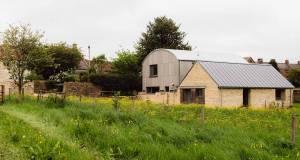- Blogs
- Posted
Lifting retrofit out of its silo
There has been a sleuth of recent reports on how to retrofit Britain’s existing homes, but we must think deeper than the practical matter of reducing energy and carbon, to how we create beautiful places to live, writes Peter Rickaby.
This article was originally published in issue 40 of Passive House Plus magazine. Want immediate access to all back issues and exclusive extra content? Click here to subscribe for as little as €10, or click here to receive the next issue free of charge
The run-up to the recent COP26 climate conference saw publication of a plethora of reports and strategies for retrofitting the UK’s buildings. They vary in scope, but most of them say the same thing: to get to zero carbon we need energy demand reduction, i.e., retrofit. The energy supply industry has a part to play in decarbonising heat and power, but without demand reduction we will not succeed. I have been reading five of those reports.
The Construction Leadership Council’s ‘Greening Our Existing Homes’ (May 2021) makes the case for the UK government, in partnership with industry, finance and community bodies, to adopt a strategy for making existing homes more energy efficient. The report describes the economic, social and environmental benefits of retrofit, sets out a fourstage implementation plan, and suggests that the UK needs 500,000 new professionals and tradespersons to deliver it by 2040.
The UK Green Building Council’s ‘Net Zero Whole Life Carbon Roadmap’ (November 2021) adopts a broader approach embracing new and existing domestic and non-domestic buildings, and whole-life emissions. The publication has four parts: a pathway summary for stakeholders, a technical report, a summary for policy makers and action plans for key stakeholders.
The ‘net zero trajectory 2018-2050’ section covers operational and construction/ retrofit emissions, identifies milestones and illustrates the scale and complexity of the challenge. Nationwide retrofitting of homes is one of five key priorities.
The London Energy Transformation Initiative (LETI) has published a ‘Climate Emergency Retrofit Guide’ (October 2021). This excellent document is the work of a consortium of a hundred building professionals, and it is exactly the guide that the industry needs. It combines a comprehensive description of retrofit with explanation of technical complexities, performance standards and guidance about strategies and how to plan and implement projects. Now that we have this guide there is no excuse for the building industry not to rise to the challenge of climate change and get on with retrofitting our buildings.
The regeneration approach should be applied to every home we retrofit.
The long-awaited Heat & Buildings Strategy published by the UK’s Business, Energy and Industrial Strategy department (BEIS, November 2021) is disappointing. It catalogues the options, but there is no critical synthesis, no clear direction of travel, and the important strategic decisions (for example about heat networks and hydrogen) are postponed. The suggestion that offshore wind generation capacity will be quadrupled provides a hint of where the balance between low carbon electricity generation and retrofit may lie: it implies that we must retrofit to reduce current heat demand by 60 per cent if we are to meet our heating needs through wind power (see my previous column in issue 39 for more on these figures).
A proposed obligation on the boiler industry to promote the installation of domestic heat pumps outside the PAS 2035 quality assurance framework has HM Treasury’s fingerprints all over it and will certainly result in heat pumps being installed in poorly insulated homes, leading to higher fuel costs and increased fuel poverty.
The Sustainable Traditional Buildings Alliance (STBA) report ‘From Retrofit to Regeneration’ (2021) reminds us that retrofitting is only one of the tasks we face in creating sustainable communities. The report recommends that the UK replaces its retrofit programmes (merely to improve energy efficiency) with strategies based on wider objectives also covering health, heritage, community cohesion, local employment, re-greening the environment, transport and flood alleviation.
Retrofit cannot be delivered in a silo: if we simply focus on insulating our homes and installing heat pumps, but leave everything else untouched, we will not achieve sustainability.
If we survive this century we will live, work, learn, socialise and travel in new ways, and our homes and other buildings will be key components of sustainable communities. Reading the STBA report reminded me of a project with which I recently assisted a housing organisation. The focus was a dilapidated, uninspiring, mid-20th century semi-detached house, although it has a substantial south-facing garden. The brief was to insulate, install a heat pump and demonstrate a path to zero carbon, but that narrow definition of retrofit is necessary but not sufficient. If we are to invest significantly in energy efficiency why not also make it a better home?
By opening the two ground-floor rooms into one open-plan space, relocating the kitchen, and replacing the rear door and kitchen window with glazed doors opening via a terrace to the garden, we could have transformed the relationship between the house and the garden.
And why not also create comfortable, well-lit zones throughout the house for sitting, cooking, eating, gaming, home working and home schooling, making it fit for the 21st century? The client embraced those suggestions, but when the cost of the retrofit came in over budget they were the first things to be cut, and the opportunity was lost.
I think the regeneration approach should be applied to every home we consider for retrofit, and regeneration applies to the interior as well as to the surroundings and the socio-economic context. With thirty years of investment in deep retrofit ahead of us, not to lift retrofit out of its current, restricted silo and integrate it with a broader, regenerative approach would be not only be a missed opportunity but also a failure of imagination.




